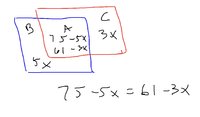eddy2017
Elite Member
- Joined
- Oct 27, 2017
- Messages
- 2,525
Hi, dear tutors: i am having difficulties in continuing to solve this ratio problem.
There are 75 students in a classes A and B altogether. There are 61 students in classes A and C altogether. The ratio of the number of students in Class B to Class C is 5:3. How many students are there in Class A?
Step 1
i added class A and B and equaled them to 75. Did the same with the classes A and B
A+B=75
A+C =61
I proceeded to set up the ratio given in the problem.
Ratio of # students in B and C
B/C= 5/3
now, i am at sea about what to do next.
thanks,
eddy
There are 75 students in a classes A and B altogether. There are 61 students in classes A and C altogether. The ratio of the number of students in Class B to Class C is 5:3. How many students are there in Class A?
Step 1
i added class A and B and equaled them to 75. Did the same with the classes A and B
A+B=75
A+C =61
I proceeded to set up the ratio given in the problem.
Ratio of # students in B and C
B/C= 5/3
now, i am at sea about what to do next.
thanks,
eddy

